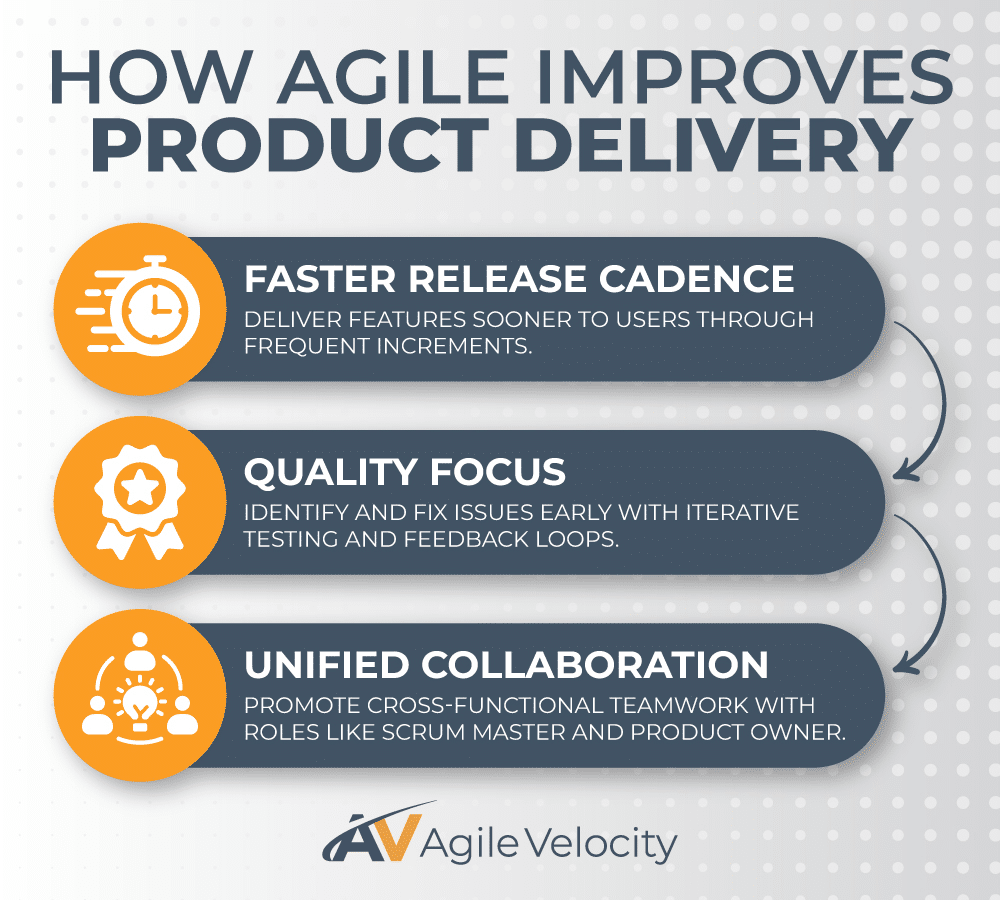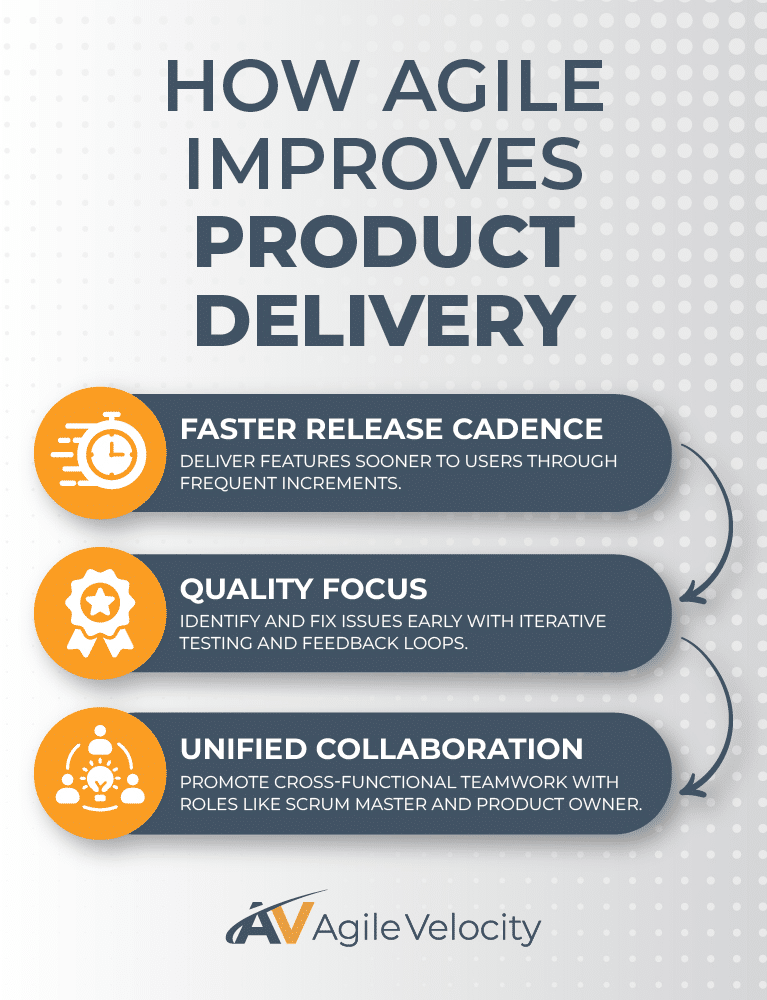Are you ready to transform sluggish processes into market-winning strategies? Delivering a product that meets customer needs quickly is vital for staying competitive. This article offers practical guidance on how to boost product delivery by aligning with customer demands, taking an outcomes-based approach, and leveraging proven Agile Methodologies.
Read on to discover how you can convert daily operations into a true competitive advantage.
What Is Product Delivery and Why Does Market Fit Matter?
Product delivery is the process of turning an idea into a finished offering that customers value. It involves everything from design and development to testing and deployment. A smooth, rapid delivery process increases the odds of achieving a strong fit with evolving market needs. At the same time, frequent updates and feedback loops enable teams to adjust swiftly.
By integrating frequent check-ins with customers, you can verify that new features or improvements match user expectations. This constant alignment means your product remains relevant, even as the market shifts. Companies that embrace an adaptive mindset and continuously improve how they work are consistently better positioned to meet, and exceed, user demands.
To further boost alignment, make sure your team maintains a clear roadmap linked to desired outcomes. For instance, syncing the team’s goals with metrics like customer satisfaction or user retention can clarify how each iteration contributes to broader objectives. When done well, this structure helps organizations pivot proactively, rather than reactively.
Aligning Teams with Customer Needs
A product delivers real value only if it solves the right problems. To ensure teams stay on track, it’s essential to integrate customer insights at every stage of development.
Start with the Customer in Mind
Use direct feedback, usage data, and collaborative sessions with end users to inform your Product Backlog and guide each Sprint. This not only enhances trust but also increases the likelihood that final outcomes will address genuine customer pain points.
Likewise, for distributed teams, occasionally holding strategic Return to Office Events can spark in-person synergy among team members and deliver deeper customer-driven alignments.
Extend Your Reach
Consider broadening your feedback sources beyond existing customers. For emerging products, interviews with potential users or adjacent markets can uncover new opportunities. Additionally, internal data from support tickets can highlight recurring issues worth tackling in upcoming Sprints.
Actionable Tips for Customer Focus
- Involve customer representatives during iteration Planning and review sessions to maintain continuous alignment.
- Incorporate usage analytics into discussions so everyone sees how customers are interacting with your product.
- Track satisfaction metrics over time, and highlight them in retrospectives to pinpoint improvement areas.
- User support tickets to identify areas of customer need or frustration that, if fixed or changed, would drive happier customers.
By focusing on customer outcomes, your organization can evolve product features based on real-world needs, avoiding the trap of building features that add little or no value.
Shifting to an Outcomes-Based Approach
Moving from task-based work to an outcomes-based focus empowers teams to measure success by real impact, not just by completing a list of tasks.
Why Outcomes Matter
Setting clear, measurable outcomes connects day-to-day tasks with overarching objectives. Instead of merely checking boxes, teams constantly consider how each goal—such as boosting retention or accelerating time-to-market—contributes to organizational success.
Building Value-Driven Teams
Leaders should be transparent about why specific outcomes matter, sharing both data and success stories. By linking each Sprint’s achievements back to these outcomes, you reinforce a sense of purpose and drive continuous progress.
This culture not only motivates team members but also strengthens collaboration, since everyone understands their role in achieving collective goals.
How Agile Improves Product Delivery
Agile practices enable rapid adaptation through short, iterative cycles—whether those cycles are known as Sprints or other time-boxed events. Each iteration offers a chance to gather customer feedback, implement improvements, and validate new features in real time.
Key Benefits of Agile
- Faster Release Cadence: Frequent increments get features to users sooner.
- Finding the Right Path: frequent feedback cycles and releases allow quicker identification of what is and what is not working for customers
- Quality Focus: Iterative testing and feedback loops identify potential issues early.
- Unified Collaboration: Roles like Scrum Master and Product Owner facilitate cross-functional teamwork.
By building on these principles, teams can continuously refine product features, ensuring that releases remain aligned with evolving customer demands.
To strengthen your Agile practice, encourage open retrospectives that examine how the team can pivot based on feedback from the previous cycle. Over time, this not only boosts product quality but also fosters a mindset of ongoing learning.
Path to Agility Navigator for Improved Delivery
Path to Agility Navigator provides a structured view of your organization’s agility journey. By highlighting where bottlenecks exist and offering clear action items, this software helps teams visualize precisely what improvements are needed and how to prioritize them.
With this tool, teams gain clarity on the most impactful steps to enhance product delivery. Path to Agility Navigator also allows you to track progress toward desired outcomes, creating transparency across different departments and championing a culture of shared accountability.
When combined with an outcomes-based approach, these insights can be transformative—helping you focus on the changes that matter most to customers and driving meaningful growth throughout your product development cycles.
Building a Culture of Continuous Improvement
A commitment to continuous improvement is vital for sustaining top-notch product delivery. This mindset empowers teams to transform minor setbacks into learning moments, consistently boosting efficiency and quality.
Fostering an Improvement Mindset
- Encourage discussions in Daily Scrum events or Sprints about what worked and what didn’t.
- Demonstrate leadership by promoting openness around failures and celebrating creative problem-solving.
- Document lessons learned and share them across teams, so knowledge transfer happens organically.
Beyond processes, continuous improvement also means keeping an eye on evolving trends and tech innovations. A willingness to experiment drives you to refine your delivery pipeline, keeping the organization agile, motivated, and ready to address new market demands.
5 Practical Tips for Enhancing Product Delivery Processes
To streamline your product delivery even further, consider these proven strategies:
1. Set Clear, Measurable Objectives
Define and communicate specific targets—like improving time-to-market or boosting monthly active users. Measurable goals keep teams aligned and spark data-driven decisions.
2. Foster Transparent Communication
Promote open dialogue in Agile events such as Daily Scrum sessions and Sprint Reviews. This reduces the risk of misunderstandings, and ensures that everyone is aware of evolving customer needs.
3. Optimize Resource Allocation
Adopt Lean Portfolio Management to align project priorities with company strategy. In addition, consider Agile Staffing to secure the right talent precisely when needed.
4. Speed Up Workflows
Automate repetitive tasks where possible. Automation frees up team members to focus on creativity and critical thinking, enhancing overall quality.
5. Review and Adapt Frequently
Schedule regular sessions to measure progress against set objectives. Use data points, feedback loops, and retrospectives to spot what’s working and what’s not. Then adjust plans accordingly to maintain momentum and high customer satisfaction.
By tackling each of these areas, you transform your product delivery pipeline into a well-oiled machine that’s continually ready to adjust to new market realities.
Overcoming Common Challenges in Product Delivery
Even with a sound plan, teams often face hurdles like shifting priorities, unclear requirements, and resistance to new ways of working. Combat such obstacles by keeping lines of communication open, clarifying goals regularly, and ensuring cross-functional roles are well understood.
When teams run into scope creep, for example, maintain clear acceptance criteria and enforce robust backlog management. If priorities do shift, conduct quick alignment events to reevaluate any changes. Addressing these issues early can keep your product delivery on schedule and reduce friction.
Additionally, empower teams with strong coaching and leadership. By providing mentorship in Agile values, you maintain cohesion, encourage risk-taking where appropriate, and guard against stagnation.
Integrating Data-Driven Decision Making into Agile Product Delivery
Accurate data is a powerful guide for refining your delivery strategy. By analyzing metrics like user engagement or feature adoption rates, teams can prioritize improvements that promise the greatest impact. Data-driven decision making also allows teams to validate assumptions quickly, accelerating the feedback loop.
To make these insights actionable, consider using dashboards that centralize performance metrics. Shared visibility encourages ownership and creates a baseline for evaluating progress in subsequent Sprints. Over time, these metrics become part of a learning cycle that drives continuous improvement.
Measuring Success and Adapting Continuously
Success in product delivery goes beyond completing tasks on schedule. Ultimately, you need to confirm that your product meets user needs and drives value for the organization.
Establishing Key Metrics
Pick a handful of meaningful metrics—like feature usage, customer satisfaction, and defect density. These indicators help you gauge performance and uncover areas for enhancement. Ensure that you understand what you are getting from your metrics, how they should trend and check them regularly.
Sharing Results
Present findings during Sprint Reviews or other routine sessions. This transparency builds trust and ensures that stakeholders stay connected with development progress, even as goals evolve.
Celebrating Wins
Recognize incremental achievements. Whether it’s improving release frequency or surpassing adoption targets, celebrating positive results fuels the energy needed to keep advancing.
The Role of Leadership and Agile Coaching in Product Delivery
Effective leadership and consistent Agile Coaching can make the difference between merely “doing Agile” and truly becoming Agile. Leaders who champion transparency, autonomy, and accountability empower teams to adopt new practices and improve existing ones over time.
Agile Coaches support these efforts by focusing on team dynamics, collaboration habits, and continuous improvement activities. When combined with strong executive backing, coaching ensures that these cultural shifts take root. As teams see tangible benefits—like fewer defects or higher customer ratings—they gain confidence to keep refining their approach.
Embracing a Future-Ready Product Delivery Process
Agility goes hand in hand with readiness for the future. By keeping an eye on market signals, technological breakthroughs, and shifting consumer preferences, your organization can pivot swiftly. Incorporating new trends such as Agile Transformation helps your team adapt its processes, while modern practices like the use of AI enable efficiencies at scale.
In parallel, focus on building an environment that fosters innovation. Encouraging safe experimentation—through small prototypes or beta tests—can help you discover creative ways to address emerging customer needs. As you evolve your delivery pipeline, regular retrospectives will reveal opportunities to fine-tune processes and keep your teams aligned with business goals.
By balancing continuous experimentation with disciplined execution, you remain prepared for whatever tomorrow’s market brings.
Emerging Trends and Best Practices in Product Delivery
Companies that successfully integrate Agile values and practices often look ahead to new methods for refining delivery. Experimenting with microservices, refining DevOps practices, or exploring advanced analytics can yield fresh ways to improve both product quality and the user experience.
Some organizations have even set up “innovation squads” dedicated to exploring nascent ideas without disrupting core operations. This approach identifies new revenue streams and uncovers improvements that can later be applied across the broader team. By staying open to emerging technologies and continuously reexamining your delivery pipeline, you ensure that processes never become stagnant.
Equally important is a culture that rewards curiosity. By adopting ongoing learning programs, your workforce grows more versatile, contributing to an environment where novel ideas can flourish.
Leveraging External Collaboration for Broader Market Insights

Teaming up with external consultants, user groups, and vendors can provide a new perspective on your product delivery approach. These outside voices may notice gaps that are less visible internally. They can also bring specialized expertise that elevates your product’s design, testing, or release processes.
Your organization stands to gain broader perspectives on user behavior as well, especially if these collaborations include guided customer interviews or shared analytics. This richer understanding of the market can bolster decision making around feature prioritization and long-term strategy.
Additional Strategies to Sustain Gains
Sustaining a competitive edge requires vigilant monitoring of internal processes—and a willingness to refine them. Regular continuous improvement sessions encourage teams to share lessons learned and propose incremental changes. Over time, this practice deepens collaboration, clarifies accountability, and strengthens your ability to address shifting business objectives.
Additionally, business operations consulting can help unify cross-department workflows, ensuring that operational hurdles don’t slow progress. As each department—from development and marketing to operations—unites behind a cohesive set of values and outcomes, everyone contributes to a consistent user experience that maintains a tight market fit. As your product matures, periodic recalibration ensures ongoing alignment with user feedback, business strategy, and emerging industry trends.
Unlock Your Product Delivery Potential Today
In a competitive environment, speed and alignment with customer needs are pivotal for achieving sustained growth. By focusing on measurable outcomes, fostering continuous improvement, and leveraging tools like Path to Agility Navigator, your teams can deliver robust products that truly fit the market.
Now is the time to unlock your full potential. Partner with Agile Velocity to streamline your processes, drive impactful change, and secure lasting market success. Let’s build the future of product delivery together!





